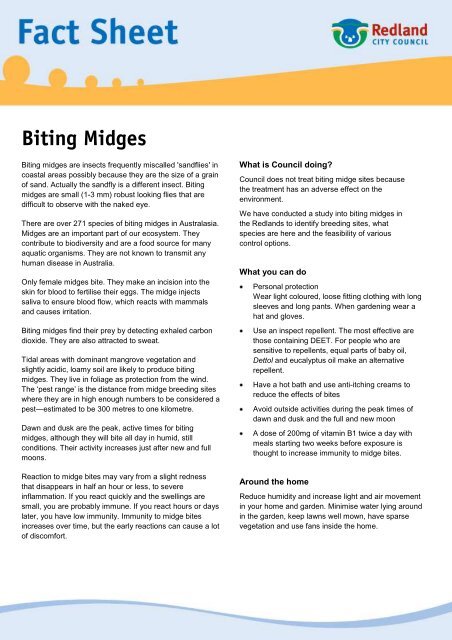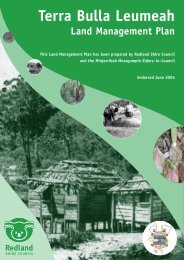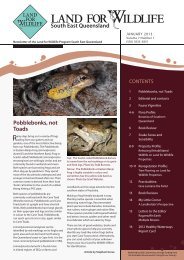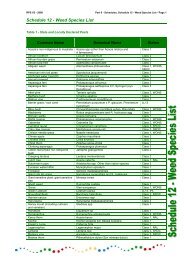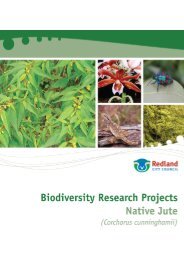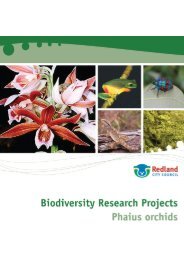Biting midges - Redland City Council
Biting midges - Redland City Council
Biting midges - Redland City Council
You also want an ePaper? Increase the reach of your titles
YUMPU automatically turns print PDFs into web optimized ePapers that Google loves.
<strong>Biting</strong> Midges<br />
<strong>Biting</strong> <strong>midges</strong> are insects frequently miscalled 'sandflies' in<br />
coastal areas possibly because they are the size of a grain<br />
of sand. Actually the sandfly is a different insect. <strong>Biting</strong><br />
<strong>midges</strong> are small (1-3 mm) robust looking flies that are<br />
difficult to observe with the naked eye.<br />
There are over 271 species of biting <strong>midges</strong> in Australasia.<br />
Midges are an important part of our ecosystem. They<br />
contribute to biodiversity and are a food source for many<br />
aquatic organisms. They are not known to transmit any<br />
human disease in Australia.<br />
Only female <strong>midges</strong> bite. They make an incision into the<br />
skin for blood to fertilise their eggs. The midge injects<br />
saliva to ensure blood flow, which reacts with mammals<br />
and causes irritation.<br />
<strong>Biting</strong> <strong>midges</strong> find their prey by detecting exhaled carbon<br />
dioxide. They are also attracted to sweat.<br />
Tidal areas with dominant mangrove vegetation and<br />
slightly acidic, loamy soil are likely to produce biting<br />
<strong>midges</strong>. They live in foliage as protection from the wind.<br />
The ‘pest range’ is the distance from midge breeding sites<br />
where they are in high enough numbers to be considered a<br />
pest—estimated to be 300 metres to one kilometre.<br />
Dawn and dusk are the peak, active times for biting<br />
<strong>midges</strong>, although they will bite all day in humid, still<br />
conditions. Their activity increases just after new and full<br />
moons.<br />
Reaction to midge bites may vary from a slight redness<br />
that disappears in half an hour or less, to severe<br />
inflammation. If you react quickly and the swellings are<br />
small, you are probably immune. If you react hours or days<br />
later, you have low immunity. Immunity to midge bites<br />
increases over time, but the early reactions can cause a lot<br />
of discomfort.<br />
What is <strong>Council</strong> doing?<br />
<strong>Council</strong> does not treat biting midge sites because<br />
the treatment has an adverse effect on the<br />
environment.<br />
We have conducted a study into biting <strong>midges</strong> in<br />
the <strong>Redland</strong>s to identify breeding sites, what<br />
species are here and the feasibility of various<br />
control options.<br />
What you can do<br />
Personal protection<br />
Wear light coloured, loose fitting clothing with long<br />
sleeves and long pants. When gardening wear a<br />
hat and gloves.<br />
Use an inspect repellent. The most effective are<br />
those containing DEET. For people who are<br />
sensitive to repellents, equal parts of baby oil,<br />
Dettol and eucalyptus oil make an alternative<br />
repellent.<br />
Have a hot bath and use anti-itching creams to<br />
reduce the effects of bites<br />
Avoid outside activities during the peak times of<br />
dawn and dusk and the full and new moon<br />
A dose of 200mg of vitamin B1 twice a day with<br />
meals starting two weeks before exposure is<br />
thought to increase immunity to midge bites.<br />
Around the home<br />
Reduce humidity and increase light and air movement<br />
in your home and garden. Minimise water lying around<br />
in the garden, keep lawns well mown, have sparse<br />
vegetation and use fans inside the home.
Midge-proof mesh is available to screen doors and<br />
windows. At peak times it may also be useful to spray<br />
screens with a low toxic surface spray. Doors should open<br />
outward to reduce the chance of <strong>midges</strong> following people<br />
inside.<br />
Light-proof curtains can reduce the number of <strong>midges</strong><br />
attracted to homes at night.<br />
Close off the sheltered side of the home during peak times<br />
as this is the side <strong>midges</strong> will enter.<br />
The natural insecticide pyrethrum, available from nurseries<br />
and hardware stores, can be used around the home and<br />
garden. It has little residual capacity so regular weekly<br />
applications will be needed.<br />
Organic insecticides can be used. These are best used on<br />
external walls or vegetation to create a barrier.<br />
Paraffin oil or perfumed lamp oil mixed with citronella or<br />
lavender oil burnt in lamps and placed upwind of outdoor<br />
activities may help to keep <strong>midges</strong> away.<br />
For more information contact Health & Environment, <strong>Redland</strong> <strong>City</strong> <strong>Council</strong>, PO Box 21, Cleveland QLD 4163,<br />
Telephone (07) 3829 8999 or visit our website www.redland.qld.gov.au.<br />
RCC 04/2009 - FS154<br />
Useful organic insecticide formulations<br />
Garlic spray<br />
85g unpeeled garlic<br />
2 tablespoons mineral oil<br />
7g soap dissolved in 600ml water<br />
Mix solution and use in a trigger spray bottle.<br />
Derris spray<br />
120g soap dissolved in 4.5L of water<br />
60g derris powder (available from garden suppliers)<br />
4.5L water<br />
Dilute entire mixture in 12L of water. Mix and use in a<br />
trigger spray bottle.


